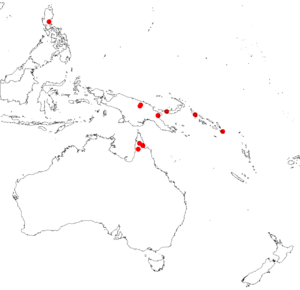Cecarria facts for kids
Cecarria obtusifolia is a unique plant that grows as a shrub in the air, not in the ground! It's a special kind of plant called a "hemiparasite." This means it gets some of its food and water from other plants, but it can also make some of its own food using sunlight. It belongs to a plant family called Loranthaceae, which includes many types of mistletoes. Cecarria obtusifolia is the only species in its group, or "genus," called Cecarria.
Quick facts for kids Cecarria |
|
|---|---|
| Scientific classification | |
| Genus: |
Cecarria
|
| Species: |
obtusifolia
|
 |
|
| Occurrence data from GBIF | |
| Synonyms | |
|
|
What it Looks Like
Cecarria obtusifolia is a shrub that grows on the stems of other plants. It's smooth all over, meaning it doesn't have any hairs. It also grows "runners" along the bark of its host plant, which help it spread.
Its leaves are shaped like an upside-down egg or a wide upside-down egg. They grow in pairs, one across from the other. The leaves have curved veins and a rounded tip. Each leaf blade is about 3 to 5.5 centimeters (1.2 to 2.2 inches) long and 2 to 4.5 centimeters (0.8 to 1.8 inches) wide. They narrow down into a very short leaf stalk, only 2 to 6 millimeters long.
The flowers grow in small clusters near where the leaves meet the stem. These clusters can be two-flowered "umbels" (where stalks come from one point) or four-flowered "racemes" (where flowers grow along a stem). Each flower has small, almost round leaves called bracts underneath it. The flowers have six separate, free petals. Inside, they have stamens (the parts that make pollen) that are almost the same size.
When the flower buds are ready to open, they are ivory-white and shaped a bit like a small club. They are about 1 to 1.4 centimeters (0.4 to 0.6 inches) long. The fruit of the plant is almost perfectly round and about 8 millimeters (0.3 inches) long.
Where it Lives
Cecarria obtusifolia can be found in several places. It grows in the Philippines, New Guinea, and the Solomon Islands. You can also find it in the Cape York Peninsula in Queensland, Australia. It also lives in the Lesser Sunda Islands and on Bougainville Island.
In Australia, this plant grows in rainforests, especially in the McIlwraith Range area of Queensland. It attaches itself to different kinds of host plants. Some of the plants it has been found growing on include Calophyllum, Casuarina, Syzygium, and Xanthostemon. Scientists believe this plant is a very old type of species, a "relict," from a supercontinent called Gondwana that existed millions of years ago.
How it Got its Name
The first time this plant was officially described was in 1906 by a scientist named Elmer Drew Merrill. He called it Phrygilanthus obtusifolius. Later, in 1973, another scientist named Bryan Alwyn Barlow studied it again. He decided it was special enough to be in its own new group, or genus, which he named Cecarria. So, the plant's name became C. obtusifolia. The most accepted description of the plant is from Barlow's work in 1984.
The genus name, Cecarria, was chosen to honor a person named Cedric Errol Carr (1892–1936). The second part of the name, obtusifolia, comes from Latin. "Obtuse" means blunt or rounded, and "folia" means leaf. So, obtusifolia means "blunt-leaved" or "rounded-leaved," which describes the plant's leaves.
Conservation Status
In Queensland, Australia, Cecarria obtusifolia is considered "Not Threatened." This means that, for now, there are enough of these plants, and they are not in danger of disappearing. This status is given under the Nature Conservation Act 1992 of Queensland.

